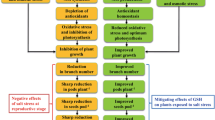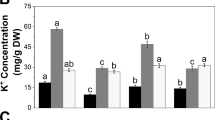Abstract
Understanding the mechanism for salt tolerance in wild soybean (Glycine soja) can help researchers improve that trait in cultivated soybean lines. We analyzed the effects of excess NaCl on the growth, physiology, and ion distribution in three soybean species: wild G. soja (W8), semi-wild G. gracilis (SW18), and the cultivated salt-sensitive G. max (cv. Melrose). These comparisons revealed that, under salt stress, shoot and root lengths and biomass (either shoot or root dry weights) were significantly higher for the W8 genotype than for the other two. Most of the morphological parameters for roots from the W8 plants were also increased, including total length, specific root length, and surface area. However, the average root diameter for W8 was significantly lower than that of either SW18 or ‘Melrose’ soybeans. In response to salinity, photosynthesis was suppressed to a greater extent in ‘Melrose’ than in W8. The relatively higher tolerance shown by W8 plants was also associated with lower levels of malondialdehyde, hydrogen peroxide, and relative electrical conductivity, but higher activities by superoxide dismutase and peroxidase, as well as more free proline and glycine betaine. In addition, the W8 plants contained less Na+ and Cl−, but more K+, and they had a higher K+/Na+ ratio in their leaves and roots when compared with either SW18 or ‘Melrose’ plants. Therefore, the W8 genotype performs better in terms of seedling growth, photosynthetic characteristics, and physiological indexes. These findings provide guidance for developing new soybean cultivars with improved tolerance to salt stress. Our data also contribute to the knowledge base for plant salt tolerance as a tool for increasing the yields of other crops in high-salinity soils.





Similar content being viewed by others
References
Abd-Alla MH, Vuong TD, Harper JE (1998) Genotypic differences in dinitrogen fixation response to NaCl stress in intact and grafted soybean. Crop Sci 38:72–77
Barrs HD, Weatherley PE (1962) A re-examination of the relative turgidity technique for estimating water deficits in leaves. Aust. J. biol. Sci 15:413–428
Bates LS, Waldren RP, Teare ID (1973) Rapid determination of free proline for water-stress studies. Plant Soil 39:205–207
Beebe SE, Rao IM, Blair MW, Acosta-Gallegos J (2008) Phenotyping common beans for adaptation to drought, in: Monneveux P, Ribaut JM (eds), Drought Phenotyping: Theory and Practice. Generation Challenge Programme, Texcoco, Mexico, pp. 311–334
Beyer WF Jr, Fridovich I (1987) Assaying for superoxide dismutase activity: some large consequences of minor changes in conditions. Anal Biochem 161:559–566
Chang RZ, Chen YW, Shao GH, Wan CW (1994) Effect of salt stress on agronomic characters and chemical quality of seeds in soybean. Soybean Sci 13:101–105
Chen P, Yan K, Shao H, Zhao S (2013) Physiological mechanisms for high salt tolerance in wild soybean (Glycine soja) from Yellow River delta, China: photosynthesis, osmotic regulation, ion flux and antioxidant capacity. PLoS One 8:1389–1392
Delgado MJ, Ligero F, Liuch C (1994) Effects of salt stress on growth and nitrogen fixation by pea, faba-bean, common bean and soybean plant. Soil Biol Biochem 26:371–376
Farquhar GD, O’Leary HM, Berry JA (1982) On the relationship between carbon isotope discrimination and the intercellular carbon dioxide concentration in leaves. Aust J Plant Physiol 9:121–137
Hameed A, Bibi N, Akhter J, Iqbal N (2011) Differential changes in antioxidants, proteases, and lipid peroxidation in flag leaves of wheat genotypes under different levels of water deficit conditions. Plant Physiol Biochem 49:178–185
Hoogenboom G, Huck MG, Peterson CM (1987) Root growth rates of soybean as affected by drought stress. Agron J 79:607–614
Jongrungklang N, Toomsan B, Vorasoot N, Jogloy S, Boote KJ, Hoogenboom G, Patanothai A (2011) Rooting traits of peanut genotypes with different yield responses to pre-flowering drought stress. Field Crops Res 120:262–270
Kashiwagi J, Krishnamurthy L, Crouch JH, Serraj R (2006) Variability of root length density and its contributions to seed yield in chickpea (Cicer arietinum L.) under terminal drought stress. Field Crops Res 95:171–181
Khanna-Chopra R, Selote DS (2007) Acclimation to drought stress generates oxidative stress tolerance in drought-resistant than-susceptible wheat cultivar under field conditions. Environ Exp Bot 60:276–283
Kondo M, Pablico PP, Aragones DV, Agbisit R, Abe J, Morita S, Courtois B (2003) Genotypic and environmental variations in root morphology in rice genotypes under upland field conditions. Plant Soil 255:189–200
Leopold AC, Toenniessen RPW (1984) Salinity Tolerance in Plants. Wiley, New York
Lichtenthaler HK, Wellburn AR (1983) Determination of total carotenoids and chlorophyll a and b of leaf extracts in different solvents. Biochem Soc Trans 11:591–592
Liu JF, Zhang SL, Dong LJ, Chu JZ (2014) Incorporation of Na+/H+ antiporter gene from Aeluropus littoralis confers salt tolerance in soybean (Glycine max L.). Indian J Biochem Biol 51:58–65
Liu W, Li RJ, Han TT, Cai W, Fu ZW, Lu YT (2015) Salt stress reduces root meristem size by nitric oxide-mediated modulation of auxin accumulation and signaling in Arabidopsis. Plant Physiol 168:343–356
Lu KX, Cao BH, Feng XP, He Y, Jiang DA (2009) Photosynthetic response of salt-tolerant and sensitive soybean varieties. Photosynthetica 47:381–387
Lu KX, Ding W, Zhu SH, Jiang DA (2016) Salt-induced difference between Glycine cyrtoloba and G. max in anti-oxidative ability and K+ vs. Na+ selective accumulation, Crop J 4:129–138
Luo QY, Yu BJ, Liu YL (2005) Differential sensitivity to chloride and sodium ions in seedlings of Glycine max and G. soja under NaCl stress. J Plant Physiol 162:1003–1012
Mekawy AMM, Assaha DVM, Yahagi H, Tada Y, Ueda A, Saneoka H (2015) Growth, physiological adaptation, and gene expression analysis of two Egyptian rice cultivars under salt stress. Plant Physiol Biochem 87:17–25
Mercedes H, Nieves FG, Pedro DV, Enrique OA (2010) Different role for hydrogen peroxide and the antioxidative system under short and long salt stress in Brassica oleracea roots. J Exp Bot 61:521–535
Mittova V, Tal M, Volokita M, Guy M (2003) Up-regulation of the leaf mitochondrial and peroxisomal antioxidative systems in responses to salt-induced oxidative stress in the wild salt-tolerant tomato species Lycopersicon pennellii. Plant Cell Environ 26:845–856
Munns, R (2002) Comparative physiology of salt and water stress. Plant, Cell. Environment 25:239–250
Mutava RN, Prince KSJ, Syed NH, Song L, Valliyodan B, Chen W, Nguyen HT (2015) Understanding abiotic stress tolerance mechanisms in soybean: a comparative evaluation of soybean response to drought and flooding stress. Plant Physiol Biochem 86:109–120
Nawaz K, Hussain K, Majeed A, Khan F, Afghan S, Ali K (2010) Fatality of salt stress to plants: morphological, physiological, and biochemical aspects. Afr J Biotechnol 9:5475–5480
Pérez-Clemente RM, Vives V, Zandalinas SI, López-Climent MF, Muñoz V, Gómez-Cadenas A (2013) Biotechnological approaches to study plant responses to stress. Biomed Res Int 2013:1–10
Puyang XH, An MY, Han LB, Zhang XZ (2015) Protective effect of spermidine on salt stress induced oxidative damage in two Kentucky bluegrass (Poa pratensis L.) cultivars. Ecotoxicol Environ Saf 117:96–106
Reddy PS, Jogeswar G, Rasineni GK, Maheswari M, Reddy AR, Varshney RK, Kisho PBK (2015) Proline over-accumulation alleviates salt stress and protects photosynthetic and antioxidant enzyme activities in transgenic sorghum (Sorghum bicolor L.) Moench. Plant Physiol Biochem 94:104–113
Rosales MA, Ruiz JM, Hernández J, Soriano T, Castilla N, Romero L (2006) Antioxidant content and ascorbate metabolism in cherry tomato exocarp in relation to temperature and solar radiation. J Sci Food Agric 86:1545–1551
Shahid M, Pinelli E, Pourrut B, Dumat C (2014) Effect of organic ligands on lead-induced oxidative damage and enhanced antioxidant defense in the leaves of Vicia faba plants. J Geochem Explor 144:282–289
Sharma P, Jha AB, Dubey RS, Pessarakli M (2012) Reactive oxygen species, oxidative damage, and antioxidative defense mechanism in plants under stressful conditions. J Bot 1:1–26
Shin R, Schachtman DP (2004) Hydrogen peroxide mediates plant root cell response to nutrient deprivation. Proc Natl Acad Sci USA 101:8827–8832
Songsri P, Jogloy S, Vorasoot N, Akkasaeng C, Patanothai A, Holbrook CC (2008) Root distribution of drought-resistant peanut genotypes in response to drought. J Agron Crop Sci 19:92–103
Warwick NWM, Halloran GM (1992) Accumulation and excretion of sodium, potassium and chloride from leaves of two accessions of diplachne fusca (L.) Beauv. The New Phytologist 121:53–61
Wu W, Su Q, Xia XY, Wang Y, Luan YS, An LJ (2008) The Suaeda liaotungensis Kitag betaine aldehyde dehydrogenase gene improves salt tolerance of transgenic maize mediated with minimum linear length of DNA fragment. Euphytica 159:17–25
Zhang HJ, Dong HZ, Li WJ, Sun Y, Chen SY, Kong XQ (2008) Increased glycine betaine synthesis and salinity tolerance in AhCMO transgenic cotton lines. Mol Breed 23:289–298
Zhang XK, Zhou QH, Cao JH, Yu BJ (2011) Differential Cl–/salt tolerance and NaCl-induced alternations of tissue and cellular ion fluxes in Glycine max, Glycine soja and their hybrid seedlings. J Agron Crop Sci 197:329–339
Zhao X, Yang XJ, Shi Y, He MZ, Tan HJ, Li XR (2014) Ion absorption and distribution of symbiotic Reaumuria soongorica and Salsola passerine seedlings under NaCl stress. Acta Ecol Sin 34:963–972
Acknowledgements
This research was supported by the Science & Technology Research and Development Guidance Plan of Baoding City, Cutting-edge and Characteristic Disciplines of Biology (Botany), Key subject of Biochemistry and Molecular Biology (Project No. 11ZF096), and funded by Heibei Province construction project in top discipline of biology. The authors are grateful to Dr. Priscilla Licht for the critical reading of manuscript.
Author information
Authors and Affiliations
Corresponding authors
Electronic supplementary material
Below is the link to the electronic supplementary material.
Rights and permissions
About this article
Cite this article
Liu, H., Song, J., Dong, L. et al. Physiological responses of three soybean species (Glycine soja, G. gracilis, and G. max cv. Melrose) to salinity stress. J Plant Res 130, 723–733 (2017). https://doi.org/10.1007/s10265-017-0929-1
Received:
Accepted:
Published:
Issue Date:
DOI: https://doi.org/10.1007/s10265-017-0929-1




